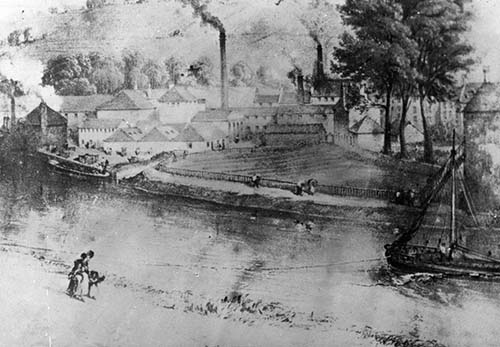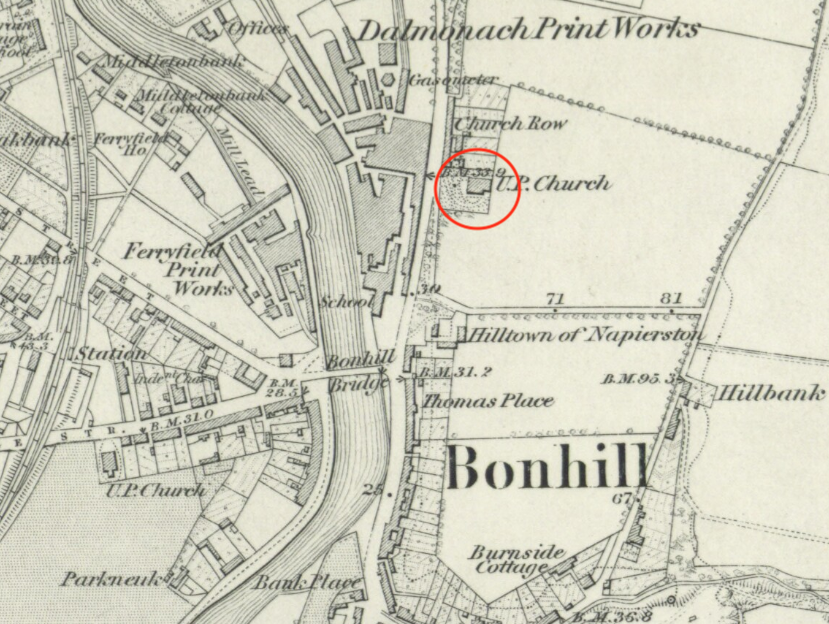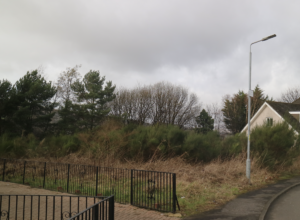
Following their meeting in Paisley on Monday 30 March, Frederick Douglass and James Buffum made their way to the home of John Murray who lived at the Customs House at Bowling Bay on the north bank of the Clyde.
This was probably where Buffum usually stayed when he was in Glasgow, while Douglass enjoyed the hospitality of the other secretary of the Glasgow Emancipation Society, William Smeal, in the city itself.
On the Tuesday, in a letter to William Lloyd Garrison, editor of the Boston abolitionist newspaper The Liberator, Buffum wrote that Murray would accompany them that evening to a meeting in Bonhill, five miles to the north west, on the east bank of the River Leven. Buffum elaborates:
We have held meetings in the west of Scotland – the towns of Ayr, Kilmarnock and Paisley, which have been the most satisfactory to us and the people. We have now commenced a series of meetings in the Vale of Leven, the place from which, as you will recollect, we had that thrilling remonstrance against our slave system in 1837, which, when it was unrolled in our annual meeting, caused such a thrill of joy to pass through all present. The people are still the same warm-hearted friends of the cause they were in 1837. They will again remonstrate in more earnest tones.1
Two ministers in the area who were involved in the anti-slavery agitation nine years before were Andrew Somerville, who helped to organise the petition, and John Robertson Swan.2 By the time Douglass and Buffum arrived, Somerville had left the United Secession church in Dumbarton in 1845 to take up a position in Edinburgh as Home and Foreign Mission Secretary, but Swan was still the minister of the Relief Church in Bonhill, and this was, almost certainly, where the meeting of Tuesday 31 March took place.3


Other meetings may have been held that week in Duntocher, Dumbarton and Helensburgh, but no newspaper reports of them have come to light.4
All we have is a letter published in the Scottish Guardian from ‘Veritas’, the pseudonym, it is thought, of the Church of Scotland minister William Gregor.5 Gregor writes of seeing Douglass and Buffum in Bonhill ‘last evening’ (i.e. 1 April), possibly a slip for the evening before, unless they held two meetings there.
The letter does not give much of an idea of the proceedings, steeped as it is in visceral antipathy for Douglass and the antislavery cause, but it is a salutary reminder that not everyone gave him a warm welcome in Scotland.
Indeed, Douglass read out this letter before an audience in Paisley on 17 April, prefaced, according to the newspaper report, with the following remarks:
The Americans seemed to speak of a slave as if he were not a man … This feeling was not confined to the United States. Some of the people here were about as bad. He had that day seen an article about Buffum and himself in a Free Church paper. The writer seemed to be very much horrified at their expressions in regard to the Free Church of Scotland; and he goes on in the strain of a slaveholder. He even in an indirect way threatens to send me back. (Laughter.) The sly reptile, however, did not give his name. The letter was really a literary phenomenon. (Laughter.)6
We reproduce the letter as it appeared in the Scottish Guardian on 14 April.
To the Editor of the Scottish Guardian
SIR. – Happening to be in this town last evening, and to hear that the celebrated Douglas, ‘the self-liberated slave,’ and Mr. Buffum, were to lecture on the horrors of slavery, and that they had been successful in other places, I went for once to hear them.
I had frequently heard of the horrifying details they give, but they came full up to the mark, and doubtless conclude that their cause was triumphant.
My objects in writing you now are to request of all and sundry who hear these men to remember that there are generally two ways of stating every controversial subject; that the public here, and especially the working classes, should postpone their judgments and withhold their opinions until they shall have heard both sides. For my own part, having heard the subject discussed during eighteen months in the city of New York, and seen the moral and religious character of the proprietors of the Southern States, blackened by every means that self-interest and the vilest hypocrisy could devise, and after having been as well informed as I could be of the parts which these proprietors take in advocating the interests of the white labourers and mechanics of the Free States, I came to the conclusion that they have far the better side of the question. Yes sir, I have come to the conclusion, however unpopular it may be with those deluded by Douglas and his constituents, that the slave proprietors of the Southern States are incalculably more the friends of civilisation on these grounds than they are.
I have not time at present to bestow, but I hope to have, and I would advise the semi-savage Douglas to be somewhat more tender-hearted in the application of his three-toed thong to the back of Dr. Chalmers and others, lest he may yet find he is only renewing these applications to himself. ‘Send the money back,’ ‘send the money back,’ ‘send the money back,’ may yet, after all his pathos, be turned into ‘send Douglas back,’ ‘send Douglas back,’ ‘send Douglas back,’ to learn more correctness in his statements, and more justness in his conclusions.
Horrifying as his statements are, with all the lies he can muster, upon the sale of human flesh, &c., what will he say when demonstrated that he and his constituents are inducing a morality incalculably more immoral, savage, barbarous, bloody, and brutal than that which he affects so much to deplore.
I can proceed no further at present than to reiterate my warning to all parties here to take time, and to withhold their opinions until both sides are heard. – I am, &c.,
VERITAS
Bonhill, 2d April, 1846
P.S. – The Free Church delegation, in appealing to the proprietors of the Southern States, have acted with an impartiality, and upon principles of an enlightened philanthropy, for which all ages shall bless them, especially the toil-worn millions.
Scottish Guardian, 14 April 1846
Notes
- James N. Buffum to William Lloyd Garrison, Bowling Bay, 31 March 1846, repr. Liberator, 1 May 1846. ‘While reading the Report, Mr. [Elizur] Wright presented the celebrated remonstrance from the people of Dunbarton [sic] and the Vale of Leven, in Scotland, which was unrolled and extended up and down the orchestra, disclosing upwards of 4,000 original signatures’: American Anti-Slavery Society, Abstract of Fourth Annual Report, repr. in Slavery in America No XIV (August 1837), p. 316. ‘All abolitionists have heard of the Vale of Leven – and remember its remonstrance to the women of America, sent over here some four years ago, and unfurled over the heads of the thousands in Broadway Tabernacle at an anti-slavery anniversary. The four thousand Scottish women who signed it dwelt in the Vale of Leven. We saw John Summerville [sic], the minister who obtained their signatures. What would induce one of our clergy – with any “weight of influence,” to be seen going about for women’s signatures to an abolition petition!’ Nathaniel Rogers, Herald of Freedom, 30 April 1841, repr. in Collection from the Newspaper Writings of Nathaniel Peabody Rogers (Concord: John R. French, 1847), p. 129.
- See ‘Chartism in the Vale of Leven’ [pdf], p.20. Somerville was inspired by a speech given by George Thompson in Dumbarton. See William Graham (ed.), Andrew Somerville, D.D…: An Autobiography (Edinburgh: Macniven & Wallace, 1880), pp. 135-8. The speech of 2 February was reported in the Liberator, 21 April 1837, which also printed the text of the Remonstrance. On antislavery activity more generally in 1837–8, most of which targeted the British government, calling for an end to the apprenticeship system in the West Indies, see Iain Whyte, Scotland and the Abolition of Black Slavery, 1756–1838 (Edinburgh: Edinburgh University Press, 2006), pp. 233–43.
- On Swan’s term of office at the Relief Church, Bonhill see William Mackelvie, Annals and Statistics of the United Presbyterian Church (Edinburgh: Oliphant & Company, 1873), p.582.
- At a speech in Belfast on 16 June, Douglass refers to having spoken in ‘Helensburgh and Dumbarton’ among other towns in Scotland (Belfast News-Letter, 19 June, 1846) and in Paisley on 6 April he refers explicitly to having recently spoken in Duntocher (Renfrewshire Advertiser, 11 April, 1846). But note that Douglass and Buffum were in Kilmarnock on Friday 3 April, so these meetings must have taken place on Wednesday 1 and Thursday 2 April.
- Iain Whyte, ‘Send Back the Money’: The Free Church of Scotland and American Slavery (Cambridge: James Clarke & Co., 2012), p. 78.
- Frederick Douglass, Paisley, 17 April 1846, Renfrewshire Advertiser, 25 April 1846.